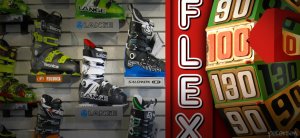Oh boy, these are some of the most “missed” numbers: mis-understood, mis-represented, and mis-referenced. We see flex ranges from 50 to 150 for adult boots. Why and how are these numbers set? You might as well try to figure out airline pricing models or the calculation of your credit score. I almost wonder if some manufacturers have a big “Price Is Right” wheel in the product room; they spin it, and whatever number it lands on will be the flex. No, that isn’t what happens, but what makes one boot a 120 and one a 130? Very good question. It tends not to be a difference in the plastic of the shell; it usually it comes down to MSRP (manufacturer's suggested retail price) or MAP (minimum advertised price). Yes, boot flex is based as much on price as on actual stiffness.
Look at any boot wall: start at the bottom and work your way up. As you do this, the numbers go up, too, both in flex and in price. Is a 120-flex boot a $100 better boot than a 110 flex, which is $100 more than a 100 flex? In many cases, no. The difference is because every $50 price point must be represented; each brand needs to offer a boot at $399 to $799 (MAP) and all of the $X49.00 and $X99.00 price points in between.
No this isn't a bad thing, you aren't being taken advantage of -- but look past the number and see the boot and what you are getting for your money. As you spend more money, usually you get higher quality. Look at the buckles: as a boot gets more expensive, the buckles will be screwed on rather than riveted, making the boot easier to work on. The cuff will be bolted on instead of riveted. The most important level of quality is a better liner. The difference between a 100- and a 120-flex boot might just be the liner, and in most cases, a better liner is well worth that step up.
All 110-flex boots are not created equal. There is no standardized rating for flex, no independent lab that tests boots and gives them a stamp of approval. This is why you hear that a boot is a stiff 110 or soft 130. You might also notice that a women’s boot is a 95 or 105 while the men's version is 100 or 110. Is there really a measurable difference of 5? Well, some feel there has to be a marketing difference because [sarcasm hat on] no woman can flex a 110 boot; a 105 is as stiff as she can handle, plus it sounds much better [/sarcasm hat off]. I use the 105/110 flexes as an example, but pick almost any manufacturer and you will see differences between men's and women's ratings.
What do all of these numbers actually mean to you? Nothing more than a point of reference. It will still come down to fit and how you flex the boot to actuate the ski to turn. Not all beginners need a soft 50-flex boot, and not all experts need an I-beam-stiff race boot, but all skiers need a boot that fits their foot and that will transfer their energy to the ski.
Link to: The Numbers Game Boots, Part 1.
Look at any boot wall: start at the bottom and work your way up. As you do this, the numbers go up, too, both in flex and in price. Is a 120-flex boot a $100 better boot than a 110 flex, which is $100 more than a 100 flex? In many cases, no. The difference is because every $50 price point must be represented; each brand needs to offer a boot at $399 to $799 (MAP) and all of the $X49.00 and $X99.00 price points in between.
No this isn't a bad thing, you aren't being taken advantage of -- but look past the number and see the boot and what you are getting for your money. As you spend more money, usually you get higher quality. Look at the buckles: as a boot gets more expensive, the buckles will be screwed on rather than riveted, making the boot easier to work on. The cuff will be bolted on instead of riveted. The most important level of quality is a better liner. The difference between a 100- and a 120-flex boot might just be the liner, and in most cases, a better liner is well worth that step up.
All 110-flex boots are not created equal. There is no standardized rating for flex, no independent lab that tests boots and gives them a stamp of approval. This is why you hear that a boot is a stiff 110 or soft 130. You might also notice that a women’s boot is a 95 or 105 while the men's version is 100 or 110. Is there really a measurable difference of 5? Well, some feel there has to be a marketing difference because [sarcasm hat on] no woman can flex a 110 boot; a 105 is as stiff as she can handle, plus it sounds much better [/sarcasm hat off]. I use the 105/110 flexes as an example, but pick almost any manufacturer and you will see differences between men's and women's ratings.
What do all of these numbers actually mean to you? Nothing more than a point of reference. It will still come down to fit and how you flex the boot to actuate the ski to turn. Not all beginners need a soft 50-flex boot, and not all experts need an I-beam-stiff race boot, but all skiers need a boot that fits their foot and that will transfer their energy to the ski.
Link to: The Numbers Game Boots, Part 1.
